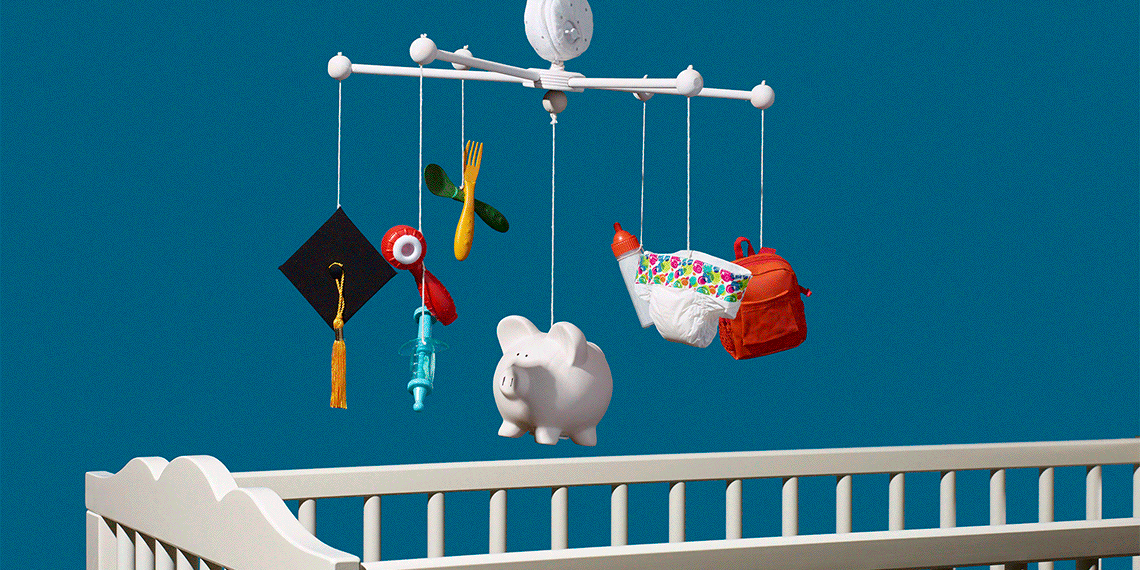
Forewarned is forearmed, especially when it comes to savings. So when you’re planning to start a family, consider how much it costs to raise a child—$233,610 by the age of 17, according to U.S. government data. To help you create a plan for this blessed event, here is an overview of how much you’ll need to save and what you’ll need to save for.
The expenses of having a child begin right away. The nationwide average for childbirth in a hospital is $12,290, or $16,907 for a C-section. This varies widely by location, and much of it may be covered by insurance. But even with insurance, the hospital stay can come with unanticipated charges from specialists. It’s best to learn as much as you can about what is covered by your insurance before your due date—and to open a savings account in anticipation of extra charges.
You and your partner will also likely want to take time off to bond with your newborn. But the majority of U.S. employers don’t provide paid maternity and paternity leave. Employees are guaranteed 12 weeks off under the federal Family and Medical Leave Act, but are not guaranteed pay for that time off.
These immediate expenses mean you’re going to need liquid assets that you can easily access when the time arrives. Here are some of the best savings accounts.
- A money market account is a good way to earn interest on your child-related savings. It also gives you regular access to your money—and even the ability to write occasional checks from the account.
- A high yield savings account is another way to make sure that your savings earn an above-average interest rate. Though you can’t write checks from it, you do have regular access to your money when you need it for big-ticket expenses.
- A certificate of deposit allows you to earn a higher rate of interest on savings for child-related expenses that are further in the future. While you won’t have the same immediate access to your money, it will earn more over time.
The good news for new parents on a budget is that family and friends will often shower you with many of the everyday necessities for a newborn, including hand-me-downs. The less-good news is that you’re still going to need a few years of diapers. In just the first year, the average baby goes through more than 2,700 disposable diapers, costing $550 on average.
But unless one parent stays home, the significant, looming expense you’re going to have to shoulder is likely childcare. According to most estimates, full-time daycare will cost you between $7,000 and $20,000 per year, while a nanny carries an average annual cost of roughly $30,000. So if your employer offers a Dependent Care Flexible Spending Account (DCFSA), now’s the time to take advantage of the ability to pay for up to $5,000 of your childcare costs from your pretax earnings annually. Also leverage the child and dependent care tax credit, which reduces taxes by up to $3,000 for one child.
Once your child is in school, your childcare expenses will shrink, but the costs of clothing—nearly 6% of the total cost of raising a child—and food rise significantly. For children ages 6 to 8, the average food expenditure per child is $2,280 per year; by age 15, it rises to $2,790 per year.
Then there’s the time off from school your child will have. Unless you stay home all summer, plan for camp. This can range from $100 a week to over $2,000 weekly. If your employer offers a DCFSA, you may be able to use it to contribute up to $5,000 of pretax dollars toward camp.
Perhaps the largest cost comes last, in the form of college. According to one survey, the yearly cost of college could be more than $120,000 for a private school and $54,000 for a public university in 18 years’ time.
A 529 plan—a college savings account—is one of the most common tax-efficient ways to save for education. Note that although you need a Social Security number to open a 529, you can use a parent’s number to open a savings account before the baby is born—or even conceived—and then transfer it to a child later on.
A Roth individual retirement account (IRA), while normally considered a savings account for retirement, is another option for making after-tax contributions to your education savings account. To make the most out of using a Roth, you may want to consider putting your contributions in a high yield CD or money market account.
Colleen Kane is a freelance writer who has written for CNBC, Fortune, Money and many other publications.
- https://www.cnpp.usda.gov/ExpendituresonChildrenbyFamilies
- https://www.fatherly.com/love-money/finances/the-real-cost-of-giving-birth-in-the-united-states/
- https://www.care.com/
- https://www.investopedia.com/articles/pf/08/budgeting-for-baby.asp
- https://www.care.com/c/stories/3326/what-does-summer-camp-cost/
- https://www.cnbc.com/2017/03/17/in-18-years-a-college-degree-could-cost-about-500000.html

